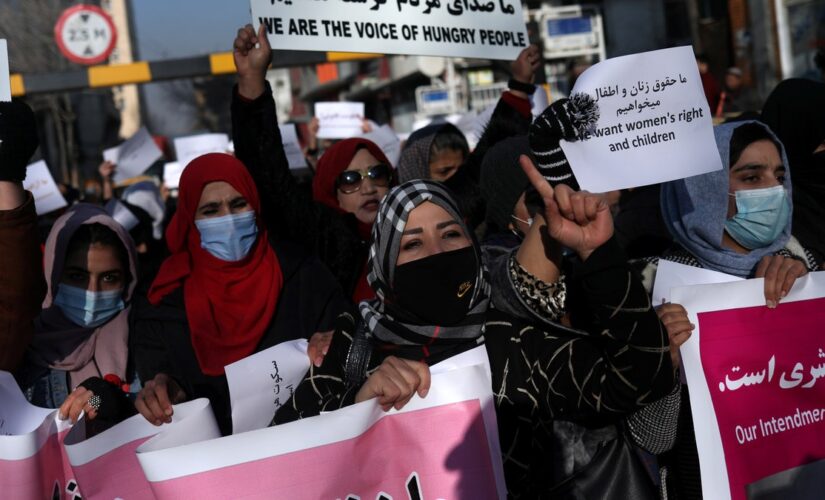Iranian women have taken to the streets to protest the country’s repressive laws against women, and women in neighboring Afghanistan are taking notice.
Widespread protests erupted across cities in Iran after the death of 22-year-old Mahsa Amini on Sept. 16 while she was detained by the morality police for violating Iran’s strict laws requiring women to cover their hair in public. What began as initial outrage over Amini’s tragic death quickly spiraled into anti-government protests and calls for the downfall of the revolutionary regime of Ayatollah Ali Khamenei.
The crackdown from Iran’s security forces, particularly the Basij paramilitary force within Iran’s Revolutionary Guard have been severe. Since protests began in mid-September, U.S.-based Human Rights Activists News Agency estimated over 400 protesters have been killed and at least 18,000 have been arrested.
Women in Afghanistan see a familiar pattern playing out against Iranian women, although on a far smaller scale at the moment. Women’s rights protests are nothing new to Iranian or Afghan society, and movements in each country have influenced each other due to cultural, linguistic and geographic proximity.
Afghan women shout slogans during a rally to protest against what the protesters say is Taliban restrictions on women, in Kabul, Afghanistan, Dec. 28, 2021.
(Reuters/Ali Khara)
IRAN PROTESTS RAGE ON STREETS AS OFFICIALS RENEW THREATS
Protesters in Iran have not lost sight of their neighbors in Afghanistan, who are also locked in a struggle with an oppressive regime that curtails women’s rights. Women in the streets are showing unity through graffiti art and protest chants.
Whether the protests in Iran will have a cascading effect on Afghanistan and the wider region will depend on how the movement can withstand the regimes forceful response and if it can survive continued repression.
The compulsory hijab has long been a source of domestic discontent for Iranian women since it was first implemented following the 1979 Islamic Revolution. Thousands marched in the streets to oppose its mandate in the early days of the new regime.
“The profound difference between today’s protests and those in the past is that women are leading them — not prominent women but often schoolgirls. This may allow the current Iranian protest movement to endure despite government efforts at suppression,” Fatemeh Aman, a non-resident senior fellow at the Middle East Institute, told Fox News Digital.
Observers say for Afghan women, the women’s rights agenda does not have nearly the national reach or support that the current Iranian protests have garnered from wide swaths of society.
A protester shows a portrait of Mahsa Amini during a demonstration to support Iranian protesters standing up to their leadership over the death of a young woman in police custody, Sunday, Oct. 2, 2022 in Paris.
(AP Photo/Aurelien Morissard)
LIFE UNDER TALIBAN RULE ONE YEAR LATER: WOMEN AND GIRLS STRUGGLE UNDER OPPRESSIVE POLICIES
Belquis Ahmadi, a senior program officer for Afghanistan at the United States Institute of Peace, notes that although protests have sprung up in several provinces outside of Kabul, the domestic political situations in Iran and Afghanistan are vastly different.
“Iranians have had almost four decades to strategize and expand their networks among men and women. In Iran, men have come out in support of women, while in Afghanistan we don’t see the level of public support from men one would have expected,” Ahmadi told Fox News Digital.
Recently, a small group of women took to the streets of Kabul to voice solidarity with the women protesting in Iran. The women gathered outside the Iranian embassy in Kabul chanting “woman, life, freedom,” a common slogan that can be heard on the streets of Iranian cities during the recent protests. This comes off the heels of a deadly terror attack on Sept. 30 at a tutoring center in the Dasht-e-Barchi area of western Kabul, a predominantly Hazara and Shia community.
The attack killed at least 53 people, including 46 girls and women. Protesters, mainly university students, took to the streets to demand answers and justice for their deaths. Taliban security forces quickly dispersed all of these demonstrators with brute force.
Since returning to power in Aug. 2021, the Taliban have rolled back many of the rights women had achieved during the 20 years after the Taliban were first ousted from power in 2001 shortly after the 9/11 terror attacks.
Women served in government positions, participated in civic life and enjoyed expanded career and educational opportunities. The Taliban quickly returned to their old ways after initial assurances that they had modernized. Just as eager young girls were about to return to school in March 2022, the Taliban reneged on their promise to allow girls above the sixth grade to return to school. Taliban fighters were guarding school entrances and refused to let girls through to class.
Afghan women chant and hold signs to protest during a demonstration in Kabul, Afghanistan, Saturday, March 26, 2022. Afghanistan’s Taliban rulers refused to allow dozens of women to board several flights, including some overseas, because they were traveling without a male guardian, two Afghan airline officials said Saturday.
(AP Photo/Mohammed Shoaib Amin)
The Taliban’s grip on society extends beyond education, and they exert almost total control over every aspect of Afghans’ lives.
Afghanistan’s Ministry for the Propagation of Virtue and the Prevention of Vice, essentially the equivalent of Iran’s morality police but said to be even more archaic and brutal, are also charged with monitoring the behavior of Afghan women in the public sphere. Among the many restrictions placed on Afghan women since the new Taliban government; women are now forced to cover their face and entire body. Women cannot control the type and color of clothes they wear, they cannot go to public parks, gyms, choose their own profession or leave the house without a male guardian.
“The Taliban have turned Afghanistan into a massive prison for women and girls,” Ahmadi said.
Despite the long odds, Afghan women have still rallied to challenge Taliban rule, even in the face of public beatings.
Iranians protests the death of 22-year-old Mahsa Amini after she was detained by the morality police last month, in Tehran, Thursday, Oct. 27, 2022.
(AP/Middle East Images, File)
Pashtana Durani, founder of LEARN Afghanistan, a nonprofit to help expand education opportunities across Afghanistan, said the protests in Iran and Afghanistan are like a rising tide of women saying they have had enough.
CLICK HERE TO DOWNLOAD THE FOX NEWS APP
“Women are fed up with men using religion to control women. And that is why they want freedom not only from a regime that oppresses them but also stand in solidarity and believe in a better world for themselves and the next generations,” Durani told Fox News Digital.




